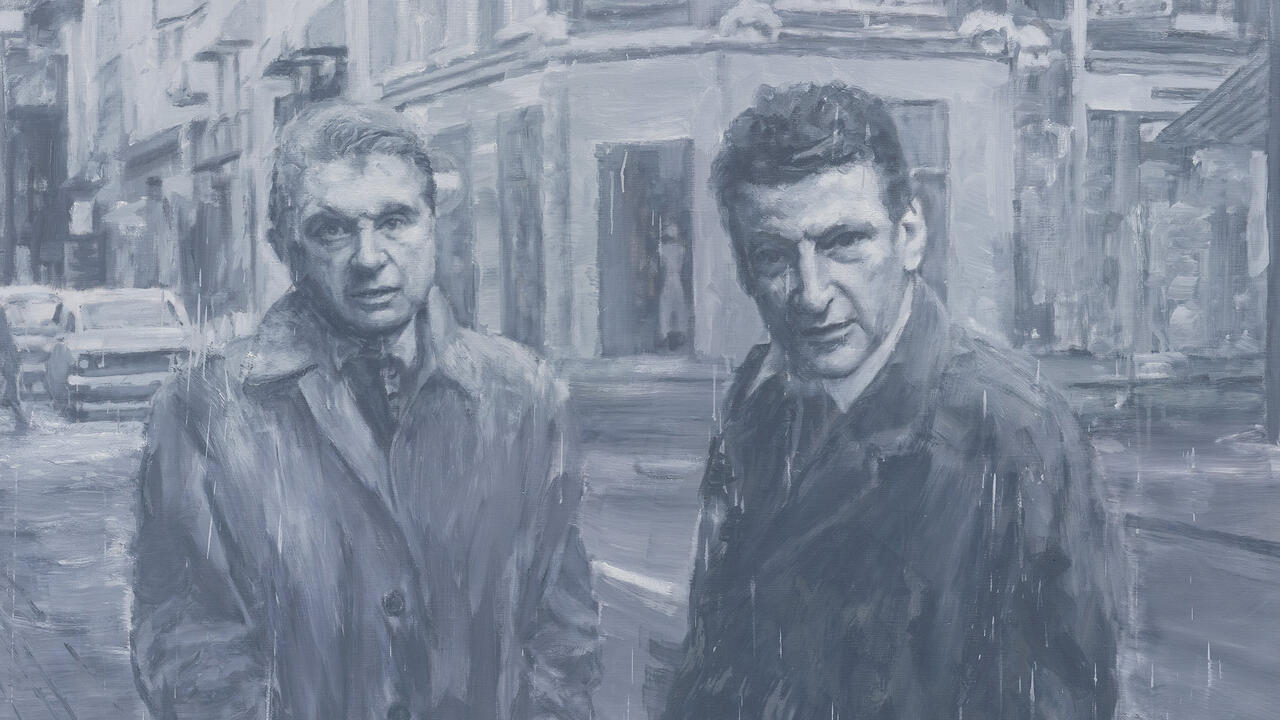Monika Stricker
Something else, all the same
Something else, all the same

When I visited Monika Stricker in her studio in Brussels in late December 2013, I found her living in strange company. The former student of Rita McBride’s at Dusseldorf Art Academy was sharing the tiny space afforded to herby a WIELS residency with an interesting but reserved family of objects (all Untitled, 2013): a series of evenly cut glass vitrines, a shiny blue car bonnet and a television set all smeared with various quantities and intensities of buttermilk, glass panels covered in a thin, cream-coloured film simulating buttermilk, riveted white paper bags filled with posters and a long, thin metal bar, among other things.
It was by anyone’s account an unusual family. Granted all families are strange but this one was particularly weird. The transparency of the glass vitrines and the reflecting lacquer of the bonnet, the hidden complexity of the television set and the simplicity of the metal bar all had very little in common. One showed an aptitude for transmitting, another demonstrated a knack for collecting and yet another for protecting. What Stricker made apparent by smearing, or simulating the smearing of, buttermilk onto these objects is that what united them was precisely their lack of any markers of locality, history or personality. The roughness of the buttermilk – curdling, congealing – exposed the smoothness, the glibness, of these objects’ surfaces. The handiwork of the smearing, left behind strokes of movement and fingerprints, drew attention to how none of these things betrayed any information about their maker.
To describe the art of Monika Stricker as a family is not merely poetic license. She engages with the objects around her as if they were relatives – not necessarily close relatives, but family members nonetheless. Staining glass vitrines with buttermilk she sometimes appears to berate her materials.At other moments, she seems to consult the objects she uses admiringly. In one of her works (Untitled, 2013) Stricker literally elevates a metal scaffolding pole to a sculpture, propping it diagonally against a wall in her studio.

Stricker hesitates in labelling her work art and this not mere false pretense. Her skepticism seems to stem, rather, from a thorough understanding of the conditions that sustain art making in the 21st century. There is sex, Michel Foucault wrote in The History of Sexuality Vol. 1 (1976; 1990), and there is sexuality. Sexuality is what happens to sex when we speak about it, when we say what is normal and abnormal, permitted and perverse. Today sex is always already an expression of sexuality. Art is no different in this respect. Stricker explained to me that once her work is conceived as art – by others or herself – it ceases to be art and is reduced to one of the various discourses about art. However much her work may have in common with traditions of minimalism and conceptualism, it cannot, in fact, belong to any of these registers.
Stricker has a long history destabilizing the relationship between material and the discourse that derives from it but that has come to precede it. Often this has been made explicit. In Tattoos, her show at the Bonner Kunstverein in 2009, she presented sculptures modelled after modern Western tattoos drawn from, but often unaware of and at odds with, ancient non-Western contexts. In 2011, for the Ida Gerhardi Preis in Ludenscheid, she exhibited film props. Displaying a spaceship container and an artificial weapon, she questioned these objects’ social and material function outside of the 2D cinematic universe: what is our physical relationship to a gun that cannot shoot? Recently, she made a series of sculptures with synthetic urine and saliva for her 2013 solo show at Clages, Cologne. Here, spraying mirrors in industrially produced bodily fluids (Untitled, 2013), Stricker humourously explored the function of urine and our relation to it (given that viewers were literally made to look at themselves in piss-stained mirrors) once it no longer bears the traces of what identifies urine as urine: smell, colour, and that most intimate relationship to our body.
The peculiar family of objects I encountered in Stricker’s studio in Brussels was less forthcoming about its concerns. What is the social nature of these materials? How is meaning assigned? How do these materials relate to one another? Stricker explores the nature of the materials around us, their ‘reality’, by imagining them beyond their simulation. She searches for a family resemblance – a structure, a receptivity that identifies them in spite, or perhaps precisely because of, their intrinsic anonymity.

















